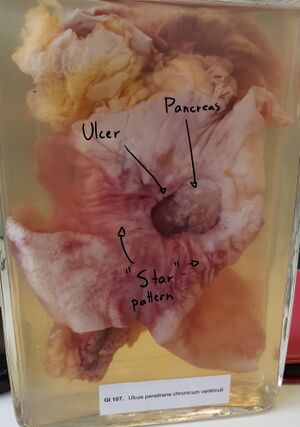3. Penetrating, chronic, ventricular ulcer (penetrating into pancreas)

Organ: Stomach
Description:
We can see that there is an ulcer on the stomach wall through which we can see the pancreas beneath. The ulcer border is sharp, the base is clean and there is a “star”-like pattern around the ulcer.
Diagnosis: Penetrating stomach ulcer
Causes:
- NSAIDs
- Helicobacter pylori
Theory:
The stomach mucosa (and the duodenum for that matter) is exposed to a lot of shit, mostly HCl and peptic enzymes. It has many protective factors against this, including:
- Mucin secretion
- High epithelial cell turnover
- Bicarbonate secretion
The latter two depend on a normal, healthy circulation and certain prostaglandins. If the balance between the protective factors and the damaging factors is disturbed will an ulcer develop.
Ulcers in the stomach develop mostly because protective factors are deficient, while ulcers in the duodenum develop mostly because damaging factors are abundant.
Ulcers in the stomach mostly cause perforation while ulcers in the duodenum mostly cause penetration. The difference is that perforation produces an opening that stomach content can enter to the abdominal cavity through, while the opening produced by penetration is covered by another organ. Duodenal content will then enter whichever organ covers the opening produced by the ulcer, like the pancreas or the liver instead of entering the abdominal cavity.
This preparation is an exception to the rule above as it shows a stomach ulcer that is penetrating instead of perforating. The ulcer directly communicates with the pancreas, meaning that stomach content could come directly in contact with the pancreas and probably cause pancreatitis.
When such an ulcer is produced must it be differentiated from cancer, as cancers may be ulcerative. Normal ulcers have sharp borders and clean bases, and often have a “star”-like pattern with “stripes” radiating out from the ulcer. Cancers have irregular borders, necrotic bases and no star pattern.
Epigastric pain is the most characteristic symptom.
